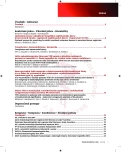Toxoplasma and immunodeficiency
Authors:
A. Obr 1; T. Papajík 1; R. Urbanová 1; K. Indrák 1; E. Buriánková 2; J. Ptáček 2
Authors‘ workplace:
Hemato-onkologická klinika LF UP a Fakultní nemocnice Olomouc
1; Klinika nukleární medicíny LF UP a Fakultní nemocnice Olomouc
2
Published in:
Transfuze Hematol. dnes,20, 2014, No. 1, p. 13-18.
Category:
Comprehensive Reports, Original Papers, Case Reports
Overview
We describe case of 34-year old man after autologous stem cell transplantation. He was examined because of fever, progression of right tonsil size, cervical lymphadenopathy, cough, neck pain, dyspnoea about 4 months after transfer of stem cells. Progressively movement dysfunction of right upper limb, urine retention, organic brain syndrome with attacks of somnolence alternate with attacks of anxiety were developed. On whole body PET/CT scan was accumulation of FDG in irregular condensations in both lung sides. Results of cultivation from peripheral blood and BAL were negative repetitively. Two demyelinating lesions were described on MRI of brain. PCR positivity of Toxoplasma was proved in cerebrospinal fluid. Extinction of aliments and health of the patient was improving during targeted antitoxoplasmic therapy. Nowadays, almost 6 years after stem cell transplantation, patient is still in complete remission of lymphoma without any consequence of toxoplasmic infection.
Key words:
toxoplasmosis, immunodeficiency, autologous stem cell transplantation
Sources
1. Ferguson DJP. Toxoplasma gondii: 1908-2008, homage to Nicolle, Manceaux and Splendore, Mem Inst Oswaldo Cruz, Rio de Janeiro, Vol. 104(2): 133-148, March 2009
2. Tenter AM, Heckeroth AR, Weiss LM. Toxoplasma gondii: from animals to humans. Int J Parasitol 2000; 30 : 1217.
3. Jones JL, Kruszon-Moran D, Sanders-Lewis K, Wilson M. Toxoplasma gondii infection in the United States, 1999, 2004, decline from the prior decade. Am J Trop Med Hyg 2007; 77 : 405.
4. Pappas G, Roussos N, Falagas ME. Toxoplasmosis snapshots: global status of Toxoplasma gondii seroprevalence and implications for pregnancy and congenital toxoplasmosis. Int J Parasitol 2009; 39 : 1385.
5. McCabe RE, Brooks RG, Dorfman RF, Remington JS. Clinical spectrum in 107 cases of toxoplasmic lymphadenopathy. Rev Infect Dis 1987; 9 : 754.
6. O’Connell S, Guy EC, Dawson SJ, et al. Chronic active toxoplasmosis in an immunocompetent patient. J Infect 1993; 27 : 305.
7. Common Parasite Potentially Increases Risk of Brain Cancers. USGS. Retrieved 8 August 2011.
8. http://www.theatlantic.com/magazine/archive/2012/03/how-your-cat-is-making-you-crazy/308873/?single_page=true
9. Remington JS, Thulliez P, Montoya JG. Recent developments for diag-nosis of toxoplasmosis. J Clin Microbiol 2004; 42 : 941.
10. Renold C, Sugar A, Chave JP, et al. Toxoplasma encephalitis in patients with the acquired immunodeficiency syndrome. Medicine (Baltimore) 1992; 71 : 224.
11. Henriquez SA, Brett R, Alexander J, Pratt J, Roberts CW. Neuropsychiatric disease and Toxoplasma gondii infection. Neuroimmunomodulation 2009; 16(2): 122-33. Epub 2009 Feb
12. Rusináková Z, Raida L, Faber E, et al. Toxoplazmóza po imunosupresivní léčbě – naše zkušenosti. Klin Mikrobiol Infekc Lek 2009 Jun; 15(3): 95-8.
13. Ciricillo SF, Rosenblum ML. Use of CT and MR imaging to distinguish intracranial lesions and to define the need for biopsy in AIDS patients. J Neurosurg 1990; 73 : 720.
14. Lorberboym M, Wallach F, Estok L, et al. Thallium-201 retention in focal intracranial lesions for differential diagnosis of primary lymphoma and nonmalignant lesions in AIDS patients. J Nucl Med 1998; 39 : 1366.
Labels
Haematology Internal medicine Clinical oncologyArticle was published in
Transfusion and Haematology Today

2014 Issue 1
- Rurioctocog Alfa Pegol vs. Non-factor Therapy – Report from Real Clinical Practice
- Cost-effectiveness in Bleeding Control for Acquired Hemophilia A
- Cost Effectiveness of FVIII Substitution Versus Non-Factor Therapy for Hemophilia A
- Vascular Disease in the Gradually Aging Population of Hemophiliacs: An Underestimated Problem?
- Prognostic Significance of Subclinical Joint Changes on MRI in Hemophilia
Most read in this issue
- Toxoplasma and immunodeficiency
- TP53 deletion in patients with multiple myeloma and monoclonal gammopathy of undetermined significance - molecular cytogenetic analysis of 84 patients
- Are we justified to classify patients with two unrelated clones with del(5q) and trisomy 8 as a subgroup of myelodysplastic syndrome of the type of 5q- syndrome?
- Optimal process for searching for adult unrelated volunteer donors in unrelated donor registries
